| Wednesday, May 7, 2008 |  |
|
|
|
 Decoherence on Metafilter: Decoherence on Metafilter: Rutgers professor of philosophy Jerry Fodor created a bit of a stir last October when he wrote an article for the London Review of Books arguing that natural selection may not be such a great theory after all, and that a "major revision of evolutionary theory... is in the offing." Not many fellow philosophers and academics agree, it seems. Fodor responds to his critics here and here. Six months later, it's still not entirely clear whether his argument is, as Justin E.H. Smith put it, "irresponsible and stupid or so subtle that none of his adversaries, defending a status quo interpretation of the theory of natural selection, have been able to get it yet." I think that's a rather brilliant article by Jerry Fodor. He starts off in part by addressing that same issue I just commented on: What’s wrong with us is that the kind of mind we have wasn’t evolved to cope with the kind of world that we live in. Our kind of mind was selected to solve the sorts of problems that confronted our hunter-gatherer forebears thirty thousand years or so ago; problems that arise for small populations trying to make a living and to reproduce in an ecology of scarce resources. But, arguably, that kind of mind doesn’t work very well in third millennium Lower Manhattan, where there’s population to spare and a Starbucks on every block, but survival depends on dodging the traffic, finding a reliable investment broker and not having more children than you can afford to send to university. It’s not that our problems are harder than our ancestors’ were; by what measure, after all? It’s rather that the mental equipment we’ve inherited from them isn’t appropriate to what we’re trying to do with it. No wonder it’s driving us nuts. But his main point is to argue a bit against that fundamental and holy principle of evolution: natural selection.
To summarize a bit: There are two fundamental, but distinct parts to the theory of evolution. 1. All life forms are evolving, later species and variants evolving from early forms, so we seem to have descended from monkeys, for one thing. 2. Evolution is happening by natural selection, i.e. by individuals and traits being selected for because they're better adapted to their environment.
Nobody but religious nuts are disputing evolution according to #1. Most evolutionists also hold #2 as being an inseparable and self-evident component in evolution. But there are many more problems with that, as Fodor points out.
Natural selection is normally presented as working exactly like how it works when somebody selectively breeds some plant or animal to cultivate particular traits. Purple roses, or fluffy short-nosed cats, etc. That selective breeding scenario is easy to understand. But the odd thing is when, in nature, it is coupled with the firm conviction that there surely is nobody there to do the selection. It is actually specifically and emphatically used to try to disprove that there's any mind involved, that there's anybody there who chooses anything. Fodor also thinks there's no mind involved and doesn't believe in God or Mother Nature. I personally would tend to think there has to be some kind of intelligence involved. Anyway, he's mainly addressing the lack of logic in the assumptions that natural selection happens based exclusively on adaptabtion to one's environment. He doesn't provide much of an alternative, but he points out that evolution would happen even without that. See, clearly, all traits aren't selected based on that they're a perfect fit for some environment. Some of them come along in the package of whatever else turns out to be advantageous. Animals that evolve to be more tame also turn out to have more floppy ears and more curly tails, even though that doesn't give them any obvious advantage. It is simply some traits that happen to be connected to the genes that relate to tameness. So, likewise, lots of traits might develop simply because they tag along with some other traits that get emphasized for one reason or another.
So, pigs don't have wings, and have never had wings, and there have never even been any pigs who went extinct because wings weren't a good idea after all. Because wings would be pretty far from the package of traits that go into a pig. A whole bunch of things would have to change at the same time, and that's not where the evolution of pigs is pointed.
I'm no biologist. But I do have a bit of a sense of what's logical and what is not. Evolutionary biology is full of anthropomorphisms that make no sense when coupled with the foregone conclusion that there's nobody there, no intelligence, that it is just all blind accidents. "Natural selection" implies that somebody selects. Genes can't be "selfish" unless they have some kind of mind. Nothing does anything "in order to" have a certain advantage unless there's something there that can make plans and choose among alternatives. So, either they haven't understood the actual mechanism that does this completely automatically, or they're missing the agent that does it. You can't really have it both ways.
[ Nature | 2008-05-07 16:35 | | PermaLink ] More >
|
|
| Monday, February 5, 2007 |  |
|
|
|

This is NASA's astronomy picture of the day for today. On January 26, people from Perth, Australia gathered on a local beach to watch a sky light up with delights near and far. Nearby, fireworks exploded as part of Australia Day celebrations. On the far right, lightning from a thunderstorm flashed in the distance. Near the image center, though, seen through clouds, was the most unusual sight of all: Comet McNaught. The photogenic comet was so bright that it even remained visible though the din of Earthly flashes. We're just missing that Superman would be flying by at the same time.
[ Nature | 2007-02-05 15:10 | | PermaLink ] More >
|
|
| Tuesday, February 22, 2005 |  |
|
|
|
 Article in NY Times: Unintelligent Design, trying to debunk the idea of intelligent design. Article in NY Times: Unintelligent Design, trying to debunk the idea of intelligent design.
Now, I've seen a lot of people complain about "Intelligent Design" being a term invented by Creationists, to covertly push the idea of Creationism, but I hadn't seen any of the materials. OK, I just searched around and found a few sites: Intelligent Design Network, Intelligent Design and Evolution Awareness Center, Origins.
Hm, seems to be about right. Those are sites that seem to try to shoot down evolution, by positioning themselves as being very objective, and pointing out the lack of evidence for evolution.
That's a shame. Oh, there isn't really much evidence for evolution. Plenty of evidence that life is evolving, and for natural selection. But very little evidence for evolution being caused by the random bumbling about that is the core of Darwinism. Nobody has found any lifeform that drew any advantage from being a half-flying bird or having half an eye or anything like that. For that matter, last I looked nobody had really found any missing links between much of anything. Oh, there are many easy ones. If it is gradually getting colder, each generation would give an advantage to the more hairy members of the species and that kind of thing, so they would be more likely to carry on the race, to become more hairy. A whole lot harder to make the case for why a wolf would jump into the ocean and develop a blow hole on its head, you know sort of randomly, a little at a time. Or how lizards who jumped out of trees got an advantage, while randomly developing flappy arms, until a few hundred thousand years later they can fly. And then there's the eye, of course.
Creationists would like to have us believe that a guy named God created it all out of thin air, fully formed, ready to go, in an enjoyable variety. And somehow they hate the idea that all of this life evolves on its own. Not for any terribly good reason other than that the Bible says God did it in seven days, and it somehow fits their belief best if it is all utterly incomprehensible and beyond humans to understand, other than in the form of knowing who to credit.
Intelligent Design is such a good term, so, yeah, it is a bit of a waste if it is just highjacked to mean anti-evolutionary creationism.
I think it is a pretty damn intelligent design. A universe with billions of galaxies with billions of stars, lasting for billions of years, with planets circling nicely around stars that provide light and heat, with elements and conditions that combine gradually into life forms. Life forms that do the most amazing things in an amazing variety. And that evolve, over millions of years, to more and more intelligent creatures, more and more adapted to their environments. In an unbroken chain over several billions of years. Until it somewhere along the line leads to US. We're pretty intelligent, although we're also pretty dumb, and is not clear yet which aspect will win. But you can't say we don't have intelligence. And we're hard at work at evolving into something better, and we probably will. Because you and I each have that several billion year unbroken success record behind us.
If all of that isn't the most intelligent design you've ever heard of, I don't know what is.
Are you going to tell me that all that could happen without it being inherent in the design of the universe that it could happen? Where on earth does intelligence suddenly come from if it isn't what naturally emerges from the layout of the universe. Just like gravity doesn't suddenly appear out of the blue for no good reason, neither does intelligence. Unless you claim to come from somewhere else, which is perfectly alright with me, your intelligence is simply a property of the universe, or the omniverse, or however big you want to look. The design is intelligent, obviously, because YOU are.
And hopefully it is a lot more intelligent than you or me individually, because humans at this point have a bit of an overblown idea of how special they are, and how much smarter they are than the universe.
That article there is a good example of that. Its argument against creationism is how badly designed everything is. You know, species die out left right and center. Life forms have loads of useless features, like the peacock's feathers, or the nipples of male humans. And that the laryngeal nerve in mammals is just too damn long. So if there were a designer, he must have been some kind of idiot. Oh, and the "moral" failures. Humans and animals are continually tortured by disease and pain and mutual cruelty. How can the designer be so mean?
See, it is all really religious arguments, for or against. It is the same kind of stuff that doubting believers in dogmatic religions go through. If God is all powerful and just, why do people starve, and why did my Uncle Harry die in a car accident, way before his time, even though he was such a good man?
Because most of the materialist evolutionist anti-creationist guys agree perfectly well with the religious creationists that the only possible God and Designer of the Universe is this archetypical greybearded fellow who just made everything up out of his little toe. And both agree that it is either that or chaos. The Creationists decide that it is most comforting if that guy did it, and that's the end of the discussion. The Evolutionists decide that no way are they going to be subjugated to that, so they choose what they think is the only alternative - the opposite. That it all happened, completely randomly, as a series of lucky accidents, out of chaos, without any kind of purpose or meaning or system. Well, actually they do a little sleight of hand trick at the same time, and imply that there's a marvelously consistent set of laws and mechanisms at work, which have worked unfailingly since the beginning of the universe. Except for that it is all just supposed to be meaningless chaos, so we go quickly past the self-contradiction in that.
Now, I'm not religious, so I don't believe in either set of dogma. They're a bit cartoonish, and neither of them is consistent with itself.
That the Design is Intelligent - that I believe in. Or, rather, there's no need to believe in it, because it is readily observable. It is the stuff you don't see that requires convoluted explanations. Just like like the fundamentalist religious person tends to get lost in circular explanations when asked to explain why an all powerful god allows pain and suffering, the fundamentalist materialist gets lost in circular complexity when asked to explain where the natural laws came from, or how human eyes assembled by accident. And mostly it adds up to: just because! You just have to believe it.
It is a shame, because it could really be so simple. If the universe itself is intelligent and alive, you don't really need to invent wild stories about how things come about. You only need those when you think you somehow are separate from the rest of the universe. What arrogance. You aren't. You're a part of a bigger system. If you're intelligent and alive, and you're a product of a bigger system, as well as an integral part of it, then of course that system is intelligent and alive. That's simple math, unless you come up with the X factor that was added to the soup to create you. And if you rather lean towards having been created by God, then how can you think you're somehow suddenly something separate from it? That's a bit of an insult to what created you. The only separation that is there is what you might create in your mind.
As to the cartoonish God-in-the-picture-of-Man who created everything, yeah, that's not a very good foundation for reality. It is an easy target. Quite easy to answer any mention of Universal Intelligence by pretending that that's what people of course are talking about. Easy to avoid the real issues, because that one discussion quickly becomes heated. And both sides are wrong.
I'm an evolving intelligent universe. I'm a design in motion, designing itself, discovering the ramifications of the design as I go along. I don't know who you are. Well, I do, actually.
[ Nature | 2005-02-22 05:18 | | PermaLink ] More >
|
|
| Sunday, August 29, 2004 |  |
|
|
|
 Picture Cassiopeia A in the most detailed image ever made of the remains of an exploded star. The colors represent different ranges of X-rays with red, green, and blue representing, low, medium, and higher X-ray energies of the supernova remnant. The one million second image shows a bright outer ring (green) ten light years in diameter that marks the location of a shock wave generated by the supernova explosion. Taken in the first half of 2004 by the Chandra Advanced Charged Coupled Device Imaging Spectrometer, launched July 23, 1999, aboard the Space Shuttle Columbia. Picture Cassiopeia A in the most detailed image ever made of the remains of an exploded star. The colors represent different ranges of X-rays with red, green, and blue representing, low, medium, and higher X-ray energies of the supernova remnant. The one million second image shows a bright outer ring (green) ten light years in diameter that marks the location of a shock wave generated by the supernova explosion. Taken in the first half of 2004 by the Chandra Advanced Charged Coupled Device Imaging Spectrometer, launched July 23, 1999, aboard the Space Shuttle Columbia.
[ Nature | 2004-08-29 22:27 | | PermaLink ] More >
|
|
| Friday, June 18, 2004 |  |
|
|
|
 What is the world coming to? The chairman of Shell Oil, Ron Oxburgh, is admitting that the threat of climate change makes him really very worried for the planet. Article at Guardian. He in part talks about how we urgently need to capture the emissions of the greenhouse gas carbon dioxide, probably a major contributor to global warming, and store it underground, a technique which is called carbon sequestration. What is the world coming to? The chairman of Shell Oil, Ron Oxburgh, is admitting that the threat of climate change makes him really very worried for the planet. Article at Guardian. He in part talks about how we urgently need to capture the emissions of the greenhouse gas carbon dioxide, probably a major contributor to global warming, and store it underground, a technique which is called carbon sequestration."Sequestration is difficult, but if we don't have sequestration then I see very little hope for the world."
"No one can be comfortable at the prospect of continuing to pump out the amounts of carbon dioxide that we are pumping out at present ... with consequences that we really can't predict but are probably not good."
"You probably have to put it under the sea but there are other possibilities. You may be able to trap it in solids or something like that."
"The timescale might be impossible, in which case I'm really very worried for the planet because I don't see any other approach." Does he really care, or is he just voicing his support for something that probably isn't going to happen anyway? I don't know. Shell is indeed a company that invests quite a bit in alternative energy sources. Do they do that just to hedge their bets, or are they willing to do something to guide things in a different direction?
[ Nature | 2004-06-18 17:28 | | PermaLink ] More >
|
|
| Friday, April 30, 2004 |  |
|
|
|
 Doc Searls: Doc Searls:I believe the Earth has a public domain dedication. More or less. OK, maybe he means that the picture of the Earth is in the public domain. But what if we meant that the Earth itself were in the public domain? Wikipedia has this to say about the public domain:Internationally, the public domain is the body of creative works and other knowledge—writing, artwork, music, science, inventions, and others—in which no person or organization has any proprietary interest (typically a government-granted monopoly such as a copyright or patent). Such works and inventions are considered part of the public's cultural heritage, and anyone can use and build upon them without restriction (not taking into account laws concerning safety, export, etc).
While copyright was created to protect the financial incentive of those doing creative work as a means to encourage more creative work, works in the public domain just exist as such, and the public have the right to use and reuse the creative work of others without financial or social burden. Doesn't completely fit, or does it? Is the Earth a creative work? Either way, imagine if the resources of the Earth were liberated from proprietary interests and couldn't be monopolized. Or does it need a stricter license, that ensures that not only can nobody own the resources for themselves, but nobody is allowed to misuse the resources? Like, you can only use resources that you replenish, and any added value that you've developed must be given back as well.
[ Nature | 2004-04-30 17:40 | | PermaLink ] More >
|
|
| Friday, January 9, 2004 |  |
|
|
|
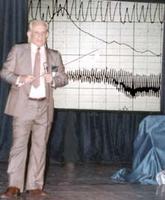 Cleve Backster is a pioneer in research demonstrating how plants, or for that matter, any live cells have some surprising abilities to respond to thoughts and feelings and communicate in ways they wouldn't traditionally be expected to. Cleve Backster is a pioneer in research demonstrating how plants, or for that matter, any live cells have some surprising abilities to respond to thoughts and feelings and communicate in ways they wouldn't traditionally be expected to."My plant read my mind!" On February 2nd, 1966 this realization forever changed the life of the FBI and CIA's then foremost polygraph researcher, and reintroduced modern science to the sentient nature of our universe. On that date the brilliant and disciplined mind of Cleve Backster conceived an irrefutable paradigm-busting scientific protocol. With straightforward electronics that a student or garage-level scientist can replicate, he proved to humans that their thoughts and emotions affect the behavior of their own and other living cells.
For millennia traditional peoples have known that all life forms-plants, animals and even single cells-are not only sentient and intelligent, but that they communicate with one another. This fact got lost a few centuries ago between the mechanistic focus of industrial science and the modern human view of reality that ascribed consciousness only to the human brain. A few 20th century scientific pioneers, like Chandra Bose in India and the Kirlians in the former Soviet Union, had earlier developed technology to demonstrate energy fields and basic emotional responses in plants and animals. Backster's experimental work took the next step and documented a heretofore unrecognized cellular level of interspecies biocommunication.
At the bottom you can find a review of Backster's new book by Paul von Ward. Now, Cleve Backster wasn't particularly the first person who experimented with this subject matter using galvanic skin response meters. For example, Ron Hubbard was playing with this in the 50s, and was generally ridiculed for it. Backster is a more respectable and mainstream character, being essentially the father of modern polygraph testing, so his message has a better chance of getting anywhere. Not that it particularly has.
Now, I know about this not just because I've listened to Clive Backster talking about it, but because I did some experiments of my own. It is very easy to do, and any skeptic ought to check it out for themselves. It is just that you need some kind of galvanic skin response meter. Like this. Which is essentially just an electronic instrument that measures resistance and that is very sensitive. A regular ohm meter isn't good enough as it isn't nearly sensitive enough. It takes something like a wheatstone's bridge, which gives large and fast readings on minute resistance changes. Or some more modern equivalent. And it needs to be attached to some suitable electrodes. For humans that would be something similar to a pair of tin cans. For a plant, the clips that otherwise would attach to the cans would do it.
So, now, for the simple and interesting experiments. You attach the clips to some plant you have standing around the house. Any plant will do, but a big leafy thing would be good. The meter will just show the needle standing rather still. If you cut off a leaf of the plant, the needle will give a sizable reaction. Not very surprising. But the surprising part is that if you take your scissor and approach the plant, intending to cut a leaf off of it, it will also react in a similar fashion, without you having touched it. It seems to react to your intention somehow. Likewise if you have several plants, maybe of the same kind. Put them in different rooms, to rule out that they can, eh, see each other. Attach the meter to one of them and have somebody watch it. Then go to the other plant and either treaten to cut one of its leaves off, or actually do so. Either way, the plant in the first room will react as if it was happening to itself.
Very simple to do. And it should certainly raise some questions in the mind of anybody who believes this would of course be impossible. And you can of course do this more scientifically and systematically, trying to exclude all sorts of other factors. And you can take it much further. And that is the kind of work that Cleve Backster has been doing.
Unfortunately, the scientific community in general has not paid much attention. As, of course, this is all impossible according to the theories that draw the most consensus, so why even bother to check it out.
[ Nature | 2004-01-09 06:24 | | PermaLink ] More >
|
|
| Friday, April 25, 2003 |  |
|
|
|
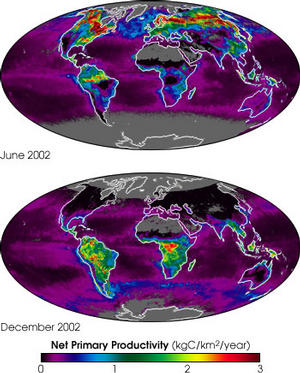 NASA announced that it has a couple of satellites that are helping to continuously map the Earth's 'metabolism'. They track the rate at which plant life is absorbing carbon (from carbon dioxide) out of the atomosphere. That shows the productivity of the Earth's carbon cycle. NASA announced that it has a couple of satellites that are helping to continuously map the Earth's 'metabolism'. They track the rate at which plant life is absorbing carbon (from carbon dioxide) out of the atomosphere. That shows the productivity of the Earth's carbon cycle.The rate of carbon fixation through photosynthesis is a basic property of life on planet Earth. It is the basis for capturing and storing the energy that fuels our world’s living systems and forms the foundation of the food webs. The oxygen we breathe is a byproduct of this photosynthesis. According to its creators, these new net primary productivity maps provide a fascinating new insight into the intimate connection between the living world and the physical world.
"We are literally watching the global garden grow,” says Steve Running, MODIS Science Team member and director of the Numerical Terradynamic Simulation Group at the University of Montana. “We now have a regular, consistent, calibrated and near-real-time measure of a major component of the global carbon cycle for the first time. This measure can also be the basis for monitoring the expansion of deserts, the effects of droughts, and any impacts climate change may have on vegetation growth, health, and seasonality." Notice that a lot of the productivity is in the oceans. About half of the total. Interesting to see those maps. It all isn't entirely in the areas I would have expected. A whole lot going on in Canada, Sweden, Siberia, and in the North Sea.
[ Nature | 2003-04-25 19:34 | | PermaLink ] More >
|
|
| Thursday, April 24, 2003 |  |
|
|
|
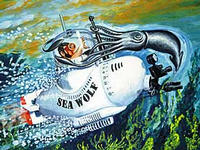 Wired has an editorial by Graham S. Hawkes suggesting a NASA for the exploration of the deep oceans. It has been noted many times that our oceans contain more mysteries and are more uncharted than is the Moon or Mars. And they're so much closer. Wired has an editorial by Graham S. Hawkes suggesting a NASA for the exploration of the deep oceans. It has been noted many times that our oceans contain more mysteries and are more uncharted than is the Moon or Mars. And they're so much closer.About 94 percent of life on Earth resides in the oceans. We've seen only about 2 percent of this vast ecosystem - the uppermost layer (home to fish, whales, scuba divers, and most known marine life). Beneath this warm lens lies a cold, dark, and life-rich realm of grand proportions. It's home to creatures as far removed from the sun and human biology as any alien imagined by science fiction.
We've seen some of these organisms clustering around midocean thermal vents - small undersea volcanoes that spew 400-degree water spiked with toxic chemicals. Thriving in total darkness, under 8,000 psi of ambient pressure, these organisms possess metabolic processes fundamentally different from ours. The ones we know about rely on chemosynthesis, using sulphides and other chemicals from Earth's core to convert seawater into food. That's about as alien as it gets. There's potentially huge resources there, and discoveries waiting to be made in how life works, in new kinds of DNA.Currently, the entire US scientific community shares a single, 12-year-old submersible named Alvin. With just one Alvin, long-range exploration is nearly impossible. Alvin doesn't even know where to go because we don't have a decent map. The latest ocean charts rely on satellites to detect the sea-level changes wrought by the gravitational pull of underlying topography. This gives us a crude sketch that's essentially useless without hands-on exploration. We can't begin to mine the sea's minerals or harvest DNA unless we go deep, with a fleet of sea exploration vessels. We need a national agency with the stated goal of exploring, mapping, and studying the oceans.
Japan is already there, having created the Japan Marine Science and Technology Center, which secures rights to deep-sea minerals, territories, and potential food sources. Its Deep Star program has even taken an early lead in DNA recovery: It's already working with the biotech industry to develop pharmaceuticals. Meanwhile, we're still combing the rain forests and wishing upon a star. Well, maybe it isn't all that terrible that the U.S. hasn't figured out how to exploit the resources of the oceans. That keeps them somewhat intact. Or just accessible to nations that are more concerned about the environment than the U.S. regime.
[ Nature | 2003-04-24 17:46 | | PermaLink ] More >
|
|
| Monday, March 31, 2003 |  |
|
|
|
 Scientists have discovered a way of recognizing the signs of life in rock formations. Essentially: create a digital image of the rock; then compress the image file. The more the file shrinks, the more likely it is that life was responsible for building the layers. Scientists have discovered a way of recognizing the signs of life in rock formations. Essentially: create a digital image of the rock; then compress the image file. The more the file shrinks, the more likely it is that life was responsible for building the layers.Although biological stromatolites and non-biological stromatolite-look-alike structures appear similar to the human eye, the biological origin of stromatolites makes them more ordered, more highly patterned. And it is this patterning that, while hard for the human eye to discern, is readily detected by the compression algorithm. Non-biological stromatolite-like structures are more random, less patterned and therefore less compressible. An online test is here. Hm, interesting. Is higher life forms more or less compressible? Would the ultimate life forms be the most compressible and embeddable? Does all of life reduce to a beautiful little formula?
[ Nature | 2003-03-31 13:26 | | PermaLink ] More >
|
|
| Monday, March 10, 2003 |  |
|
|
|
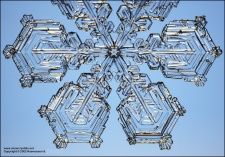 Cool pictures of snow crystals. Thanks Seb. And Michael Wilson found this site about how snow crystals are formed. Cool pictures of snow crystals. Thanks Seb. And Michael Wilson found this site about how snow crystals are formed.
[ Nature | 2003-03-10 18:33 | | PermaLink ] More >
|
|
| Wednesday, March 5, 2003 |  |
|
|
|
Nice article at Kuro5hin about the potential for profitable power from ocean waves. Harvesting hydro electric power from waves has been a tricky undertaking, but apparently progress is happening. Lots of details and references about the technology.
[ Nature | 2003-03-05 23:59 | | PermaLink ] More >
|
|
| Saturday, March 1, 2003 |  |
|
|
|
 Paul Stamets is a mushroom prophet. Well, he's an expert on fungi and mycelia - the underground networks of which mushrooms are the fruits. And he has apparently made many interesting discoveries, particularly concerning the capabilities of mycelia to clean up polluted soil. He calls it 'mycoremediation'. There is a nice article, originally from Whole Earth Magazine. Paul Stamets is a mushroom prophet. Well, he's an expert on fungi and mycelia - the underground networks of which mushrooms are the fruits. And he has apparently made many interesting discoveries, particularly concerning the capabilities of mycelia to clean up polluted soil. He calls it 'mycoremediation'. There is a nice article, originally from Whole Earth Magazine. A couple of years ago Stamets partnered with Battelle, a major player in the bioremediation industry, on an experiment conducted on a site owned by the Washington State Department of Transportation in Bellingham. Diesel oil had contaminated the site, which the mycoremediation team inoculated with strains of oyster mycelia that Stamets had collected from old-growth forests in the Pacific Northwest. Two other bioremediation teams, one using bacteria, the other using engineered bacteria, were also given sections of the contaminated soil to test.
Lo and behold. After four weeks, oyster mushrooms up to 12 inches in diameter had formed on the mycoremediated soil. After eight weeks, 95 percent of the hydrocarbons had broken down, and the soil was deemed nontoxic and suitable for use in WSDOT highway landscaping. By contrast, neither of the bioremediated sites showed significant changes.
[ Nature | 2003-03-01 23:59 | | PermaLink ] More >
|
|
| Tuesday, February 11, 2003 |  |
|
|
|
 BBC report that farmers in India have had success with cotton crops that were genetically modified to resist insects. They achieved dramatically increased yields and needed significantly less pesticide treatment. BBC report that farmers in India have had success with cotton crops that were genetically modified to resist insects. They achieved dramatically increased yields and needed significantly less pesticide treatment.
Is that good? I'm not sure. What I mostly have against GM is that it is manipulation of nature done by people who largely don't know what they're doing. Like people making nuclear bombs in their kitchens without bothering to check what they actually do. They don't think about the whole system. But neither does traditional mainstream farmers. They seem equally oblivious to the needs of ecosystems. Lots of technologies, like genetic engineering, might be a perfectly fine idea, if they were in knowledgable and responsible hands. I don't think they are.
[ Nature | 2003-02-11 23:59 | | PermaLink ] More >
|
|
| Saturday, February 8, 2003 |  |
|
|
|
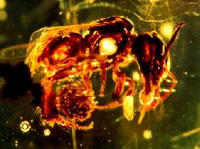 I think the world of microbial organisms is really fascinating. For example, there have been various discoveries of how amazingly sturdy microbes can be, and how they can survive in what we would consider the most inhospitable environments. I think the world of microbial organisms is really fascinating. For example, there have been various discoveries of how amazingly sturdy microbes can be, and how they can survive in what we would consider the most inhospitable environments.
Just recently, scientists discovered that there is plenty of life even deep below the ocean floor. They sampled 3.5 million year old crust 1000 feet below the bottom of the Pacific Ocean. There is an enormous pressure, and none of the normal energy sources that life depends on. But different microbes exist there. Another story here , about rock-eating microbes on the sea floor. It estimates that 10-30% of the Earth's bio-mass consists of microbes deep inside the crust.
Bacteria also have amazing abilities to survive for a long time under extreme conditions in a suspended state.On April 20, 1967, the unmanned lunar lander Surveyor 3 landed near Oceanus Procellarum on the surface of the moon. One of the things aboard was a television camera. Two-and-a-half years later, on November 20, 1969, Apollo 12 astronauts Pete Conrad and Alan L. Bean recovered the camera. When NASA scientists examined it back on Earth they were surprised to find specimens of Streptococcus mitis that were still alive. Because of the precautions the astronauts had taken, NASA could be sure that the germs were inside the camera when it was retrieved, so they must have been there before the Surveyor 3 was launched. These bacteria had survived for 31 months in the vacuum of the moon's atmosphere. Perhaps NASA shouldn't have been surprised, because there are other bacteria that thrive under near-vacuum pressure on the earth today. Anyway, we now know that the vacuum of space is not a fatal problem for bacteria. Or, even more wild, 30 million year old bacteria have survived in amber:Biologists Raœl Cano and Monica Borucki had extracted bacterial spores from bees preserved in amber in Costa Rica. Amber is tree-sap that hardens and persists as a fossil. This amber had entrapped some bees and then hardened between 25 and 40 million years ago. Bacteria living in the bees' digestive tracts had recognized a problem and turned themselves into spores. When placed in a suitable culture, the spores came right back to life. Those last two are from Cosmic Ancestry, a very interesting site supporting the possibility that life on Earth has been seeded from space. Here's another recent article about that, suggesting that life probably exists now on Mars, under similar conditions as what we find in the Earth's crust, and that it is quite likely that the process here was seeded by microbes from Mars.
[ Nature | 2003-02-08 23:59 | 0 comments | PermaLink ]
|
|
| Saturday, January 25, 2003 |  |
|
|
|
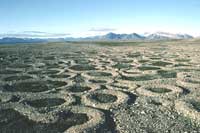 Scientific American reports that scientists feel they've found an explanation to how stones manage to self-organize. In many polar and high alpine areas stones form strange circular patterns. Now they've identified how that might take place quite naturally through repeated freezing and thawing. Well, self organization IS the most natural thing in the world, whatever the medium. Scientific American reports that scientists feel they've found an explanation to how stones manage to self-organize. In many polar and high alpine areas stones form strange circular patterns. Now they've identified how that might take place quite naturally through repeated freezing and thawing. Well, self organization IS the most natural thing in the world, whatever the medium.
[ Nature | 2003-01-25 23:59 | 0 comments | PermaLink ]
|
|
| Sunday, January 12, 2003 |  |
|
|
|
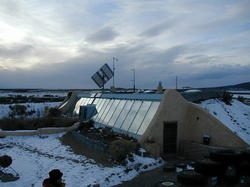 Mark Woods mentions an article about Earth Ships, which says, for example: Mark Woods mentions an article about Earth Ships, which says, for example:"Inside, the sunlight was terrific, the entire space fairly cozy, but very hobbit-like. And with, let's be clear, fairly low resale value to anyone except a total granola-crunching lunatic like yourself, unless there's a nuclear war and living off the grid becomes handy, at which point you won't want to move anyway, but will want to insert steel bars over all the windows to avoid mutant tribes of 16-eyed irradiated flesh-eating Objectivists." Earthships are houses built of old tires and dirt, and maybe old cans and bottles. Not as crazy as it sounds. It is a way of recycling materials in a sensible way, to build a sustainable, durable, well-insulated house. You can build it yourself.
[ Nature | 2003-01-12 17:42 | | PermaLink ] More >
|
|
| Friday, December 27, 2002 |  |
|
|
|
 Evolution on this planet has gone through many steps towards developing gradually more complex creatures. There seems to be a fractal nature to evolution, where for example stages that microbes pass through in a small scale are later repeated at higher levels of complexity. Young life forms will often irresponsibly try to use up all available resources, and will act aggressively against their neighbors, but later on in the cycle, as they become more mature, the various players will negotiate mutually beneficial arrangements amongst each other. The microbes are in many ways ahead of us complex humans in terms of figuring out how different kinds of beings can live together in peace, to everybody's mutual benefit. Evolution on this planet has gone through many steps towards developing gradually more complex creatures. There seems to be a fractal nature to evolution, where for example stages that microbes pass through in a small scale are later repeated at higher levels of complexity. Young life forms will often irresponsibly try to use up all available resources, and will act aggressively against their neighbors, but later on in the cycle, as they become more mature, the various players will negotiate mutually beneficial arrangements amongst each other. The microbes are in many ways ahead of us complex humans in terms of figuring out how different kinds of beings can live together in peace, to everybody's mutual benefit.
Even the most small and simple single celled organisms, bacteria, classified as monera, specialized themselves in amazing ways and organized themselves into complex social structures where they were supporting each other's existence. They specialized in breaking down different kinds of chemicals, and other bacteria would start using the chemicals the first produced, etc., forming a complete ecosystem. That was 1.7-3.7 billion years ago. These organisms then moved on to a higher level of cooperation. Multiple different kinds of creatures together formed a cell. These cells, which formed another kingdom called protista, were around a thousand times bigger than the monera. They were still single-celled, but we could say that they are multi-creatured, because they combine many previously separate creatures into one unit.
The protists, large multi-creatured cells, further evolved. At first they were prokariotes (before nucleus) and then they developed into eukariotes (cells with a nucleus). Eukariotes are now around a thousand times bigger than the prokariotes. Essentially they are very complex bacterial cooperatives, in many ways as complex as human cities, containing millions of specialized parts that would have been independent life forms in previous evolutionary steps. The nucleus of the cell is the information center, containing a DNA blueprint of how things are arranged.
Next step is that multiple nucleated cells combine into multi-celled creatures. And on and on to more and more complex multi-celled creatures, with more and more different specialized parts. Along the way death is invented, to make it easier to improve on the designs along the way, while recycling the old models.
Now, billions of years later, we humans have developed reflective intelligence, so we have the luxury of being able to sit and think about these things. But we are also rather ignorant about the complex social order that adds up to our existence. And we tend to be rather arrogant about it, even thinking that all these tiny creatures are nothing but a nuissance to us. Not realizing that our own bodies are amazingly complex cooperative organizations of billions of cells that each are complex organizations of millions of smaller specialized creatures. And all of it is pretty much working in perfect unison. And we humans tend to be so naive that we think that our conscious awareness is somehow in control of all of this, despite that we hardly understand it, and we mostly are totally unconscious of it.
Anyway, a question is what comes next, beyond us humans maturing into figuring out how we all can co-exist on the same planet. One quite logical thought would be that we all will arrange ourselves as components of a bigger organism of a higher order. That we'll be cells in the global brain, so to speak, and that humanity maybe will become conscious as a whole. Or, maybe other, more unexpected things will happen. Maybe parts of each of us will start cooperating with each other, and new kinds of life forms will emerge.
I'm no biologist. Better places to study some of this would be, for example the book Earth Dance - Living Systems in Evolution by Elisabet Sahtouris.
[ Nature | 2002-12-27 23:59 | | PermaLink ] More >
|
|
| Thursday, December 26, 2002 |  |
|
|
|
APP/ENN: "Microbes in the water may have a greater capacity to devour fuel waste than originally thought, a new study found, suggesting the harbor could cleanse itself within 20 years, barring any major fuel leaks, according to Derek Lovley, a microbiologist at the University of Massachusetts. [...] The key appears to be the presence of sulfate, a salt of sulfuric acid which is abundant in seawater, Lovley said. The microbes appear to use it as a substitute for oxygen, breaking down the waste in the same way humans use oxygen to break down their food."
[ Nature | 2002-12-26 04:55 | | PermaLink ] More >
|
|
|
|
ENN/Reuters: "U.S. greenhouse gas emissions linked to global warming fell by 1.2 percent last year, the largest decrease in a decade, due in part to slow economic growth and a milder winter, the government said recently. Last year's decline was in sharp contrast to the average 1.3 percent annual growth rate in U.S. emissions from 1990 to 2000 and was twice the level of the only other drop since 1990 — a 0.6 percent decline in 1991 — according to a report from the Energy Information Administration (EIA)..."
[ Nature | 2002-12-26 04:55 | | PermaLink ] More >
|
|
Page: 1 2 Older stories >> |
 Decoherence on Metafilter:
Decoherence on Metafilter: 
 Article in NY Times: Unintelligent Design, trying to debunk the idea of intelligent design.
Article in NY Times: Unintelligent Design, trying to debunk the idea of intelligent design.
 Picture Cassiopeia A in the most detailed image ever made of the remains of an exploded star. The colors represent different ranges of X-rays with red, green, and blue representing, low, medium, and higher X-ray energies of the supernova remnant. The one million second image shows a bright outer ring (green) ten light years in diameter that marks the location of a shock wave generated by the supernova explosion. Taken in the first half of 2004 by the Chandra Advanced Charged Coupled Device Imaging Spectrometer, launched July 23, 1999, aboard the Space Shuttle Columbia.
Picture Cassiopeia A in the most detailed image ever made of the remains of an exploded star. The colors represent different ranges of X-rays with red, green, and blue representing, low, medium, and higher X-ray energies of the supernova remnant. The one million second image shows a bright outer ring (green) ten light years in diameter that marks the location of a shock wave generated by the supernova explosion. Taken in the first half of 2004 by the Chandra Advanced Charged Coupled Device Imaging Spectrometer, launched July 23, 1999, aboard the Space Shuttle Columbia.  What is the world coming to? The chairman of Shell Oil, Ron Oxburgh, is admitting that the threat of climate change makes him really very worried for the planet. Article at Guardian. He in part talks about how we urgently need to capture the emissions of the greenhouse gas carbon dioxide, probably a major contributor to global warming, and store it underground, a technique which is called carbon sequestration.
What is the world coming to? The chairman of Shell Oil, Ron Oxburgh, is admitting that the threat of climate change makes him really very worried for the planet. Article at Guardian. He in part talks about how we urgently need to capture the emissions of the greenhouse gas carbon dioxide, probably a major contributor to global warming, and store it underground, a technique which is called carbon sequestration. Doc Searls:
Doc Searls: Cleve Backster is a pioneer in research demonstrating how plants, or for that matter, any live cells have some surprising abilities to respond to thoughts and feelings and communicate in ways they wouldn't traditionally be expected to.
Cleve Backster is a pioneer in research demonstrating how plants, or for that matter, any live cells have some surprising abilities to respond to thoughts and feelings and communicate in ways they wouldn't traditionally be expected to. NASA announced that it has a couple of satellites that are helping to continuously map the Earth's 'metabolism'. They track the rate at which plant life is absorbing carbon (from carbon dioxide) out of the atomosphere. That shows the productivity of the Earth's carbon cycle.
NASA announced that it has a couple of satellites that are helping to continuously map the Earth's 'metabolism'. They track the rate at which plant life is absorbing carbon (from carbon dioxide) out of the atomosphere. That shows the productivity of the Earth's carbon cycle. Wired has an editorial by Graham S. Hawkes suggesting a NASA for the exploration of the deep oceans. It has been noted many times that our oceans contain more mysteries and are more uncharted than is the Moon or Mars. And they're so much closer.
Wired has an editorial by Graham S. Hawkes suggesting a NASA for the exploration of the deep oceans. It has been noted many times that our oceans contain more mysteries and are more uncharted than is the Moon or Mars. And they're so much closer. Scientists have discovered a way of recognizing the signs of life in rock formations. Essentially: create a digital image of the rock; then compress the image file. The more the file shrinks, the more likely it is that life was responsible for building the layers.
Scientists have discovered a way of recognizing the signs of life in rock formations. Essentially: create a digital image of the rock; then compress the image file. The more the file shrinks, the more likely it is that life was responsible for building the layers. Cool pictures of snow crystals. Thanks Seb. And Michael Wilson found this site about how snow crystals are formed.
Cool pictures of snow crystals. Thanks Seb. And Michael Wilson found this site about how snow crystals are formed. Paul Stamets is a mushroom prophet. Well, he's an expert on fungi and mycelia - the underground networks of which mushrooms are the fruits. And he has apparently made many interesting discoveries, particularly concerning the capabilities of mycelia to clean up polluted soil. He calls it 'mycoremediation'. There is a nice article, originally from Whole Earth Magazine.
Paul Stamets is a mushroom prophet. Well, he's an expert on fungi and mycelia - the underground networks of which mushrooms are the fruits. And he has apparently made many interesting discoveries, particularly concerning the capabilities of mycelia to clean up polluted soil. He calls it 'mycoremediation'. There is a nice article, originally from Whole Earth Magazine.  BBC report that farmers in India have had success with cotton crops that were genetically modified to resist insects. They achieved dramatically increased yields and needed significantly less pesticide treatment.
BBC report that farmers in India have had success with cotton crops that were genetically modified to resist insects. They achieved dramatically increased yields and needed significantly less pesticide treatment.
 I think the world of microbial organisms is really fascinating. For example, there have been various discoveries of how amazingly sturdy microbes can be, and how they can survive in what we would consider the most inhospitable environments.
I think the world of microbial organisms is really fascinating. For example, there have been various discoveries of how amazingly sturdy microbes can be, and how they can survive in what we would consider the most inhospitable environments.
 Scientific American reports that scientists feel they've found an explanation to how stones manage to self-organize. In many polar and high alpine areas stones form strange circular patterns. Now they've identified how that might take place quite naturally through repeated freezing and thawing. Well, self organization IS the most natural thing in the world, whatever the medium.
Scientific American reports that scientists feel they've found an explanation to how stones manage to self-organize. In many polar and high alpine areas stones form strange circular patterns. Now they've identified how that might take place quite naturally through repeated freezing and thawing. Well, self organization IS the most natural thing in the world, whatever the medium. Mark Woods mentions an article about Earth Ships, which says, for example:
Mark Woods mentions an article about Earth Ships, which says, for example: Evolution on this planet has gone through many steps towards developing gradually more complex creatures. There seems to be a fractal nature to evolution, where for example stages that microbes pass through in a small scale are later repeated at higher levels of complexity. Young life forms will often irresponsibly try to use up all available resources, and will act aggressively against their neighbors, but later on in the cycle, as they become more mature, the various players will negotiate mutually beneficial arrangements amongst each other. The microbes are in many ways ahead of us complex humans in terms of figuring out how different kinds of beings can live together in peace, to everybody's mutual benefit.
Evolution on this planet has gone through many steps towards developing gradually more complex creatures. There seems to be a fractal nature to evolution, where for example stages that microbes pass through in a small scale are later repeated at higher levels of complexity. Young life forms will often irresponsibly try to use up all available resources, and will act aggressively against their neighbors, but later on in the cycle, as they become more mature, the various players will negotiate mutually beneficial arrangements amongst each other. The microbes are in many ways ahead of us complex humans in terms of figuring out how different kinds of beings can live together in peace, to everybody's mutual benefit.